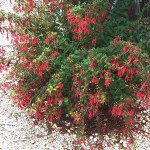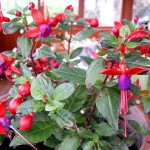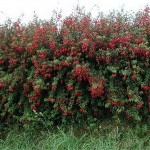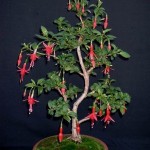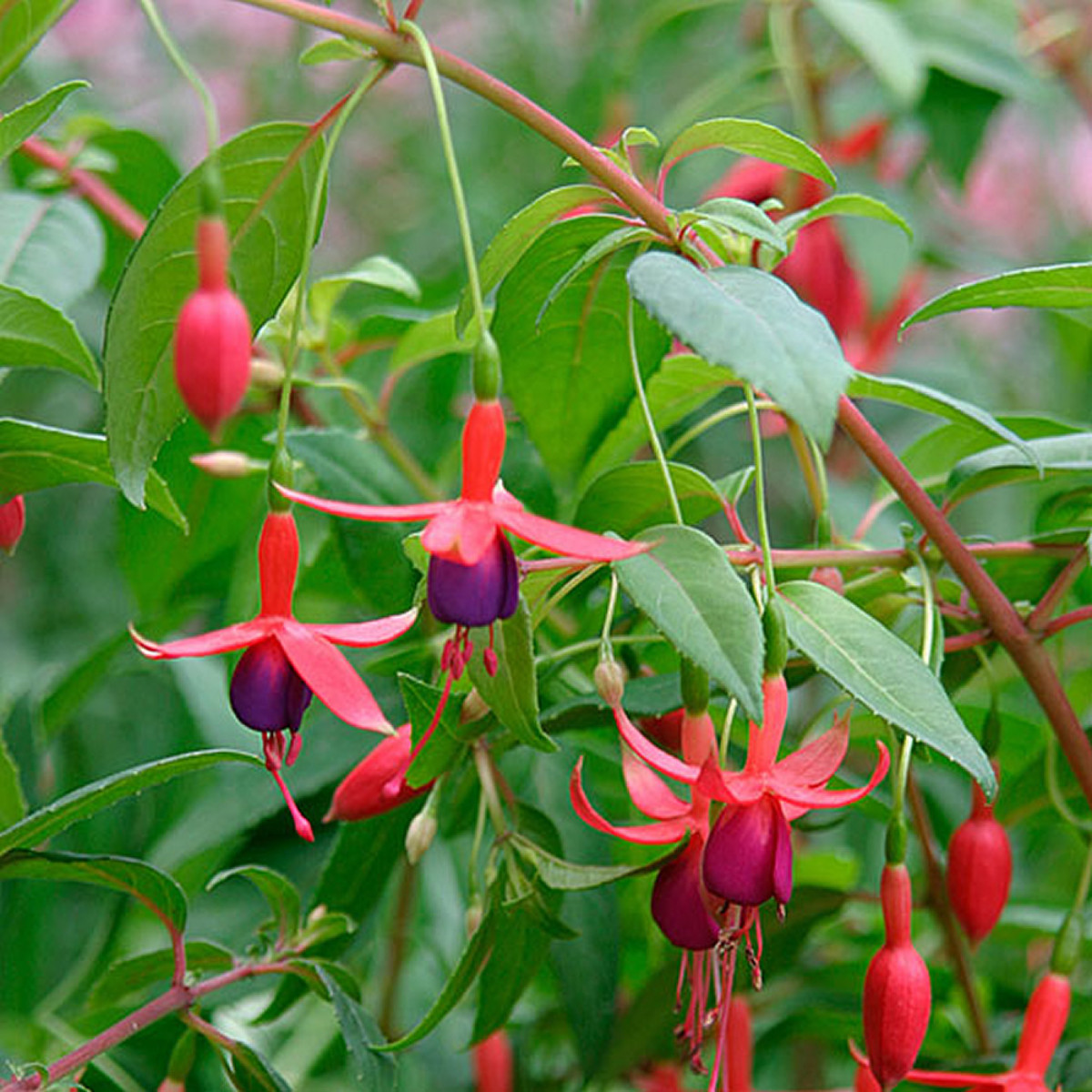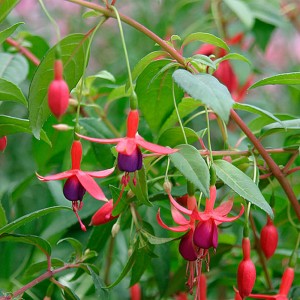Family: Onagraceae
Synonymous: Fuchsia gracilis
Fuchsia macrostemma
Fuchsia magellanica var. gracilis
Fuchsia magellanica var. macrostema
Fuchsia riccartonii
Distribution and habitat: Fuchsia magellanica is found in forest clearings and margins, especially in mixed evergreen/deciduous woods of South America - Argentina and Chile. Also, this plant was widely naturalised in Bolivia, the UK, the Azores, the Canary Islands, eastern Africa, New Zealand, Hawaii, western USA (California and Oregon) and in the coastal districts of southern Australia.
Description: Fuchsia magellanica is an upright deciduous shrub with lance shaped leaves that have reddish undersides. It grows to 3.6m (11 feet) by 2m (6 feet) at a medium rate and produces many small, tubular, pendent flowers in shades of red, pink and sometimes white. The branching structure is horizontal with the flowers dangling beneath the stems. The flowers are emerging from a deep tube that flares to become pointed petals, while the corolla and petals are protrude. Blooms profusely over a long period from late spring through late fall. The flowers are hermaphrodite (have both male and female organs) and are pollinated by insects. Flowers are followed by reddish purple fruits.
This cold tolerant species is the parent of most hybrid cultivars of today.
Gardening: Fuchsia magellanica plants are popular garden shrubs with medium growth rate and, once planted, they can live for years with a minimal amount of care. These plants are hardy in mild temperate areas. The long branches may be nipped during frosty weather, but the shrub will rebound in spring. In Hardiness Zone 6 a heavy mulch in late fall will help to bring plants through the winter.
Keep these plants blooming longer by picking off spent blooms and seed pods. To encourage branching, prune plants heavily in the spring and pinch off the tips of the new growth. Continue to pinch until the plant is filled out.
Location: Fuchsia magellanica prefers part sun. It should be located in morning sunlight and afternoon shade, especially in warm, sunny climates. Very dense shade is not desirable as it will inhibit flowering.
Soil: Plant Fuchsia magellanica in rich, moist soil. If the soil does not drain well or puddles after a rain, improve drainage by mixing 8 to 10cm (3 to 4 inch) of organic material such as compost.
Irrigation: Water Fuchsia magellanica deeply enough to saturate the soil only when the top 3 to 5cm (1-2 inch) of soil is dried. Do not over-water. The plant will be more susceptible to fungal disease if the soil is not allowed to dry between watering.
Fertilisation: Feed the Fuchsia magellanica every three to four weeks during spring and summer, using an all-purpose fertiliser for blooming plants. Alternatively, apply a balanced time-release fertiliser every three to four months. Apply the fertiliser after watering and never fertilize dry soil. Refer to the fertiliser label for specific instructions and rates of application, which may vary depending on the size of the plant and the type of soil.
Container plants: Fuchsia magellanica is a favorite for hanging baskets and, under the proper care, will give abundant colorful blooms throughout the season. But this plant is difficult to keep in good condition indoors without a cool, shaded planthouse or conservatory. Good air circulation is essential, but shelter it from hot, dry winds, which remove moisture too rapidly and cause wilting.
Occasionally trim back the long branches of Fuchsia magellanica kept in a hanging basket to obtain a fuller plant. Trimming the plant will not harm it, but enable it to bush out and create more blossoms.
Light: Fuchsia magellanica enjoy bright light, but keep it safe from the hot afternoon sunlight.
Temperature: Fuchsia magellanica are not frost hardy and like a mild winter temperature of 10C (50F), especially when grown as potted plants. In cold winter areas, Fuchsia magellanica needs special care over winter. Prune the plant back to 10 to 15cm (4-6 inch), removing all leaves and store it in a cool, dark place. Placing it in a dark environment will prevent the plant from beginning to sprout and grow before climate conditions are optimum. Water the dormant Fuchsia magellanica plant only two or three times just to prevent the potting mixture to dry completely during this resting period. When the last frost has passed, move Fuchsia magellanica back to its summer placement so it can begin to grow.
Water: Water them regularely. To water Fuchsia magellanica, submerge the pots in room-temperature water until completely saturated and then allow them to stand until all dripping has stopped. Do not allow the plants to remain in standing water or root rot may result. On hot days, mist the foliage with water.
Feeding: Feed Fuchsia magellanica with a water-soluble bloom fertilizer.
Potting and repotting: Grow them in large 25 to 30cm (10-12 inch) pots or hanging baskets of rich, peaty compost mixed with sand and bone meal. Repotting should be strictly attended to, never allowing the plant to form a mat of roots around the ball before it gets a shift into a larger pot.
Propagation: Fuchsia magellanica can be propagated easily from softwood cuttings. The best time to root them is spring or autumn. The cutting should be 8cm (3 inch) in length potted singly in 5cm (2 inch) pots, in three parts sand, one part loam and another of leaf-mold. Place the pots in a shady position with a temperature of not less than 15C (60F) at night. When the small plants are well rooted, shift them along into a 10cm (4 inch) pot, using this time potting mixture recommended for adult plants. In this size of pot, the shoot will have made four or five joints and should now be pinched to encourage side breaks. The plant, where it is stopped, will start into two breaks and the strongest should be taken for a leader; pinch the weaker one when two leaves are well formed. Strict attention from now on should be paid to keep the plants in good shape. The side shoots must be kept in bounds, so that the symmetry of the plant is preserved, pinching "the stronger ones hard and allowing the weaker to grow a little longer so that they gain more vigour. The leader may be allowed to make six pairs of leaves, and then be stopped, always choosing the strongest breaks to increase the height of the plant.
Problems:
Watch out for scale insects and spider mites, pests which love to invade Fuchsia magellanica. Problematic mites include the fuchsia gall mite (Aculops fuchsiae) and red spider mite (Tetranychus urticae).
Treatment: First thoroughly spray the plant, both top and underside of leaves with water, then administer either insecticide or insecticide soap according to the label instructions.
Fuchsia magellanica are eaten by the caterpillars of some Lepidoptera, such as the Elephant Hawk-moth (Deilephila elpenor) and the Black-lyre Leafroller Moth ("Cnephasia" jactatana). Other major insect pests include aphids, mirid bugs such as Lygocoris, Lygus and Plesiocoris spp., vine weevils (Otiorhynchus spp.), and greenhouse whitefly (Trialeurodes vaporariorum).
Treatment: Use an adequate pesticide following the label recommendations.
Rust (Puccinia graminis), gray mold (Botrytis blight), crown gall (Agrobacterium tumefaciens), rots (Phytopthora cinnamomi), southern blight (Sclerotium rolfsii) and verticillium wilt (Verticillium alboatrum and Verticillium dahliae) can also damage or kill Fuchsia magellanica shrubs.
Treatment: Because eradicating these bacterial diseases is difficult or impossible, the best recourse for infected plants is to remove and destroy them. The treatment begins with good sanitation to prevent the spread of the disease. Destroy affected plants and remove the surrounding soil and garden debris that has come in contact with them. Do not transplant any nearby plants to other parts of the garden. Quarantine new plants by growing them in a bed that is isolated from the rest of the garden until proven that they are disease-free.
Life span: Fuchsia magellanica plants will remain in bloom for several weeks, with each flower lasting several days, depending on location and care. The plants can last for years with proper care.
Companion plants: Fuchsia magellanica mixes well with other semi-tropical flowers, such as Salvia, Plectranthus and Justicia species.
Note: Fuchsia magellanica is regarded as an environmental weed in some parts of the world such as Australia and some islands in the Indian Ocean.
Uses and display: Fuchsia magellanica is used for planting in temperate and subtropical gardens, within conservatories and for containers on patios, balconies and sunny houseplant positions. Fuchsia magellanica adds bright colors and a tropical feeling to the garden. Use as a specimen or in a bed or border. It is noted for attracting wildlife.
Fuchsia magellanica is a large, fairly hardy, tropical-looking shrub with many showy flowers, used as beds, borders and hedge plant in garden or as specimen plant in containers.
Height: 60-120cm (23-47 inch)
Spread: 60-90cm (23-35 inch)
Hardiness zone: 6a-9b

